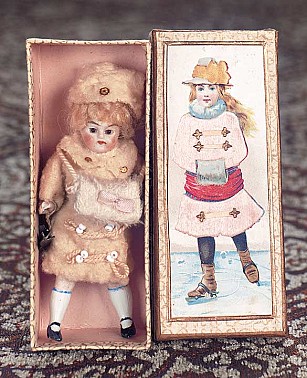Extremely Rare French Bisque Poupee with Unique Construction and Portrait Face
Lot #171
17" (43 cm.) Bisque head with slender heart-shaped
face,high domed forehead and flat-cut elongated
throat that is swivel-attached to original
shoulder plate that has a sculpted blushed dimple
at the center and unusually-high throat
extension,painted dark blue eyes in sculpted eye
sockets,heavily-modeled eyelids,dark eyeliner,grey
eye shadow,arched feathered brows,painted
lashes,accented nostrils and eye corners,closed
mouth with center accent line,aquiline-shaped
nose,impressed dimples at lip corners,philtrum and
the bottom lip,un-pierced blushed ears,brunette
mohair wig over cork pate,kid-over wood poupee
body with very shapely torso,accentuated
derriere,dowel-jointing at shoulders,hips and
knees,bisque arms to above the elbows with
delicately curved elbows,cupped hands with defined
fingers,ivory satin silk gown with seed pearls and
Alencon lace ornamentation,undergarments,shoes
signed "Maison Giroux Paris",and luxurious crown
of seed pearls set in a gilt frame. Condition:
generally excellent,small repair to one finger.
Comments: maker unknown,circa 1867,although the
unusual neck articulation appears to be from the
1852 depose of Marie Cruchet that was used by
various doll makers. The doll was likely presented
at the 1867 Universal Exposition in Paris; only
six other models from this series are known to
exist,one of them appearing in the book,A Fully
Perfected Grace,by Florence Theriault,and believed
to be a portrait of 18th century Princess
Lamballe. The dolls appear to be from a series of
dolls representing French royalty or aristocracy.
It is possible,but not certain,that this model is
a portrait of Princess Mathilde Bonaparte who was
a prominent member of Paris society during the
1860s. Value Points: the extreme rarity of the
doll,as well as its superb refinement,unusual
construction details,and elegant presence indicate
its importance; its fine state of preservation
enhances these features.










































































































































































































































































































































































































































































